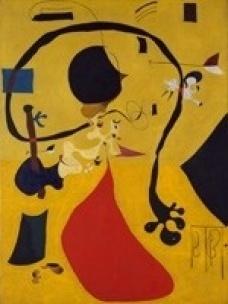
newspaper
agenda cultural
During a trip to the Netherlands in spring 1928, the Catalan painter Joan Miró (1893-1983) purchased postcards from the museums he visited
Two 17th-century Dutch genre scenes particularly caught his attention and served as the inspiration for a series of paintings he created that summer. The traveling exhibition Miró: The Dutch Interiors, which opens at the Rijksmuseum, Amsterdam, and will be on view at The Metropolitan Museum of Art beginning October 5, features Miró's three "Dutch Interiors" and the two Old Master paintings on which they are based. The New York venue will also show preparatory drawings and additional paintings by Miró in the Metropolitan's collection. This exhibition is the first in which Miró's paintings have been hung alongside the Dutch Golden Age pictures that inspired them.
The exhibition was organized by The Metropolitan Museum of Art, New York, and the Rijksmuseum, Amsterdam.
Exhibition OverviewThe exhibition brings together three paintings by Miró—Dutch Interior I (The Museum of Modern Art, New York), Dutch Interior II (Peggy Guggenheim Collection, Venice) and Dutch Interior III (The Metropolitan Museum of Art, New York)—that were based on two 17th-century works in Amsterdam's Rijksmuseum. The Dutch paintings—The Lute Player (1661) by Hendrick Sorgh and Children Teaching a Cat to Dance (c. 1660-79) by Jan Steen—both feature a musician, an audience of one or more people, and a cat and a dog. When reinterpreted by Miró, the scenes undergo a complete metamorphosis.
When Steen's humorous genre scene was transformed into the imaginative Dutch Interior II, Miró enlarged and focused on the animate figures—both human and animal—while de-emphasizing the inanimate objects. The cat is at the swirling center of Miró's composition, and the noise and chaos of the dancing lesson are communicated through motion and rhythm.
In addition, a fourth picture, now in the collection of the Metropolitan Museum, will be included in the exhibition. The Potato was considered by Miró to be part of his Dutch Interior series, and obviously recalls his impressions in the Netherlands.
Although there is a long history of artists who sought inspiration in the work of other artists, this encounter between the Dutch Masters and one of the most esteemed avant-garde artists of the 20th century is both unexpected and rare. Through a selection of preparatory drawings that will also be displayed, viewers will see how Miró moved from representational sources to his own language.
Related ProgramsA series of gallery talks, which are free with Museum admission, will complement the exhibition.
The exhibition will be featured on the website of the Metropolitan Museum (www.metmuseum.org).
CreditsAt the Metropolitan, the exhibition has been organized by Gary Tinterow, the Engelhard Chairman of the Department of Nineteenth-Century, Modern, and Contemporary Art, assisted by Nykia Omphroy. Exhibition design is by Michael Langley, Exhibition Design Manager; graphics are by Kamomi Solidum, Associate Graphic Designer; and lighting is by Clint Ross Coller and Richard Lichte, Lighting Design Managers, all of the Museum's Design Department.
Prior to its presentation at the Metropolitan Museum, the exhibition was on view at the Rijksmuseum in Amsterdam, The Netherlands.

Joan Miró (Spanish, 1893–1983). Dutch Interior (III), 1928. Oil on canvas; 51 1/8 x 38 1/8 in. (129.9 x 96.8 cm). The Metropolitan Museum of Art, New York, Bequest of Florene M. Schoenborn, 1995 (1996.403.8). © 2010 Successió Miró / Artists Rights Society

